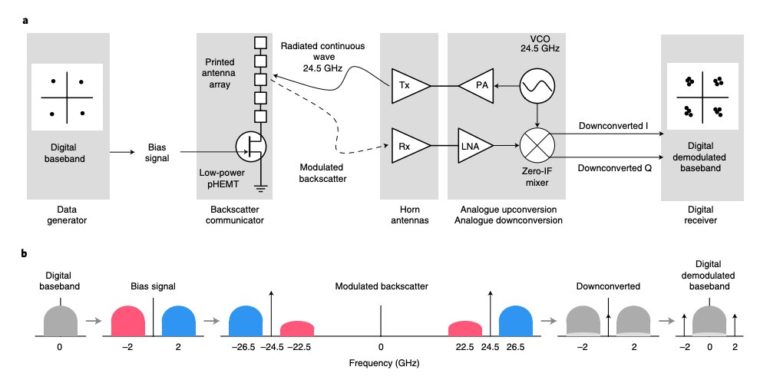The number of smartphones, laptops and other devices connected to the internet is continuously increasing. This expanding network of connected devices, also known as the Internet of Things (IoT), entails the transfer of large amounts of data over the internet.
To support the substantial exchange of information between IoT devices worldwide, computer scientists must develop robust and scalable communication systems that allow users to transfer data quickly between devices without consuming too much power. One promising approach to enable wireless communication is known as backscatter radio.
Essentially, backscatter radio enables wireless communications via a process known as ‘reflection,” rather than via radiation. This approach enables the transmission of data without the need for batteries or power grid connections, using an antenna to pick up radio frequency signals.
Backscatter radios have several advantages, including low manufacturing costs, minimal complexity and the ability to operate without batteries. However, to achieve high data rates and a low power consumption these tools might still need to be integrated with more advanced wireless communication techniques.
Researchers at Herriot-Watt University and Nokia Bell Labs have recently developed a new system to achieve backscatter communications at gigabit data rates, comprised of a millimeter-wave modulator and an antenna array. This system, introduced in a paper published in Nature Electronics, achieved both a remarkable bit rate and a low energy consumption.
“We report a mm-wave modulator and antenna array for backscatter communications at gigabit data rates,” John Kimionis, Apostolos Georgiadis, Spyridon Nektarios Daskalakis, and Manos M. Tentzeris, the researchers who carried out the study, wrote in their paper. “This radiofrequency front end consists of a microstrip patch antenna array and a single pseudomorphic high-electron-mobility transistor that supports a range of modulation formats, including binary phase shift keying, quadrature phase shift keying and quadrature amplitude modulation.”
The circuit within the system created by Kimionis and his colleagues was fabricated using a technique known as inkjet printing, a type of computer printing that can recreate a digital image by pushing droplets of ink onto paper and plastic substrates. To print their circuit, the researchers specifically propelled silver nanoparticle inks onto a flexible liquid-crystal polymer substrate.
Additionally, they designed a mm-wave transceiver that could capture backscattered signals and route them for digital signal processing. While previous studies already explored the analog modulation of backscatter signals, Kimionis and his colleagues took this idea one step further by introducing an analog control signal in the gate of a commercial off-the shelf transistor.
In initial evaluations, the printed millimeter-wave modulator and antenna-based system developed by this team of researchers achieved highly promising results. More specifically, the system achieved a remarkable bit rate of two gigabits per second of backscatter transmission at millimeter-wave frequencies of 24-28 GHz, with a front-end energy consumption of 0.17pJ per bit.
In the future, backscattering at millimeter-wave frequencies could broaden the compatibility of devices to 5G without the need to incorporate complex or expensive components. This recent study confirms the potential of systems that enable millimeter-wave backscattering, such as the one developed by Kimionis and his colleagues.
Backscatter breakthrough runs near-zero-power IoT communicators at 5G speeds everywhere
More information:
A printed millimetre-wave modulator and antenna array for backscatter communications at gigabit data rates. Nature Electronics(2021). DOI: 10.1038/s41928-021-00588-8.
2021 Science X Network
Citation:
Researchers realize a printed millimetre-wave modulator and antenna array for backscatter communications (2021, July 14)
retrieved 15 July 2021
from https://techxplore.com/news/2021-07-millimetre-wave-modulator-antenna-array-backscatter.html
This document is subject to copyright. Apart from any fair dealing for the purpose of private study or research, no
part may be reproduced without the written permission. The content is provided for information purposes only.



